Proposal:Pipeline valves proposal
| The Feature Page for this approved proposal is located at Tag:pipeline=valve |
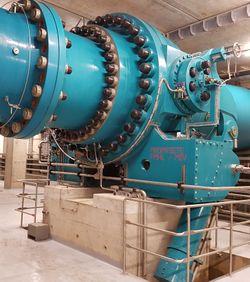
| Pipeline valves proposal | |
|---|---|
| Proposal status: | Approved (active) |
| Proposed by: | fanfouer |
| Tagging: | pipeline=*
|
| Applies to: | |
| Definition: | Propose to improve pipeline valves mapping and description with valve=*
|
| Statistics: |
|
| Draft started: | 2017-12-19 |
| RFC start: | 2018-11-15 |
| Vote start: | 2018-12-16 |
| Vote end: | 2019-01-15 |
Rationale
Valves are important devices to regulate flows, block liquids or ensure security in piping systems. There are many shapes and functions existing. We can find them in many places, to begin with households or heavy industries.
Knowing their function, to which pipes they are connected to or their figures may be important to describe a more complex system.
Valves are installed on fire or utility hydrants or emergency systems also.
Improving and extending OSM model for valves may bring benefit to several fields of knowledge and may allow to merge some redundant tags.
It will improve knowledge of man made pneumatic and hydraulic systems.
Proposal
It is proposed to complete the pipeline and waterway valves tagging with the following tags :
valve=*actuator=*sensor:position=*handle=*turn_to_close=*
There is no point to deprecate any existing tag here.
Valves have been mapped for years in OSM and this current proposal only add tagging details about them.
This proposal focus on tags to use if, and only if, data is available. It does not assume all data can be publicly known but provide a consistent model to add it to the map if possible, without any pipeline operator help.
How to map
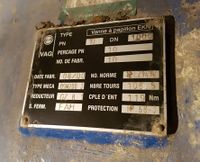
First of all, don't go inside private or restricted perimeters if you're not invited to do so please, some valves may not be safely accessible and you may expose yourself to multiple hazards.
Public information or aerial imagery will help to see outdoor pipeline facilities safely.
On every valve device found and on a man_made=pipeline way (not surrounding building, not fence), add a ![]() and put some tags described below like mandatory
and put some tags described below like mandatory pipeline=valve.
Use location=* to give information about its position and valve=* to let us know about its mechanism.
High detailed information may be found on valves themselves. A complete datasheet as exposed beside gives many figures on the device capabilities and structure.
We basically need nominal diameter, valve mechanism but manufacturer=* and start_date=* may also be completed.
Nevertheless, you may not be able to took picture of those plates and as a reminder : don't go inside restricted perimeters to get the one you couldn't unless invited
Tagging
| Key | Value | Comment | Recommendation |
|---|---|---|---|
| pipeline | valve |
Valves are usually mapped as |
mandatory |
| valve | <valve technology> | The design of the valve | recommended |
| location | <location> | The physical location of the valve, such as indoor. See below for possible values. | recommended |
| diameter | <nominal diameter> | The nominal diameter of the valve in millimeters according to ISO 6708 | optional |
| operator | <operator> | Name of the company that operates the valve. | optional |
| manufacturer | <Manufacturing company> | Name of the company that built the valve | optional |
| ref | <reference> | Abbreviation / number of the valve. | optional |
| turn_to_close | clockwise or anti_clockwise |
Direction of rotation wheel to close the valve. This is common to handle and actuator | optional |
| handle | <handle model> | Does a handle is available on the valve? See below for possible values | optional |
| actuator | <actuator technology> | Mode of actuating the valve. See below for possible values | optional |
| sensor:position | <position sensor> | Position sensor design used to get the valve current status. Not fluid pressure or chemical sensor which may be installed beside the valve | optional |
| remotely_controllable | Control mode | How the actuator is remotely activated to change the valve state. | optional |
There is no point to add substance=* tag on the valve regulating pipes. This is a matter for pipelines and not for valves themselves.
Valve designs

Valves may have specific design inside a given network to fulfill a function. The design is visible on the ground and doesn't correspond to the usage or function of the valve.
| Key | Value | Comment |
|---|---|---|
| valve | butterfly | A butterfly valve a quarter-turn valve design and uses a rotating disk to regulate or ensure complete isolation of the flow of a fluid. |
| globe | A globe valve allows flow regulation and involves a movable disk in a static ring. It shouldn't be confused with ball valves. | |
| ball | A ball valve is a quarter-turn valve design and uses a rotating perforated ball to regulate or ensure complete isolation of the flow of a fluid. It is designed for high pressure delta between upstream and downstream | |
| plug | It's similar to ball valve, with a perforated cylinder rotating quarter-turn. | |
| gate | A gate valve is kind of on/off valve and opens by lifting a sluice out of a liquid flow. It doesn't allow flow regulation. | |
| needle | A needle or a pointy moving part at least regulate the opening of the fluid duct. It is used to regulate the fluid intake on power hydro turbines for instance | |
| spool | A spool valve allows to open and shut several ducts in a single movement. A single moving part is regulating several intakes and the possible configurations are set by design. |
Valve actuators
Actuators allow to modify the valve state, eventually open or close it completely with or without human action needed. This key is intended to describe the nominal actuator used to open or close the valve.
| Key | Value | Comment |
|---|---|---|
| actuator | manual | The most common actuator : human hands. This is default and implicit. |
| electric_motor | An electric motor is used to change the valve state | |
| pneumatic_cylinder | A cylinder powered by pressurised air change the valve state | |
| hydraulic_cylinder | A cylinder power by pressurised fluid (mainly oil) change the valve state | |
| thermostatic | A mechanical actuator based on the ambient temperature to adapt the valve opening. Often used on domestic heating radiator globe valves | |
| solenoid | The movable parts of the valve are moved with the help of electromagnetic force, without contact with any static part |
As to prevent additional damages in case of automated actuator failure, manual mode may be always be available beside the nominal actuator.
There is no need to add ';manual' in actuator=* value. Prefere using handle=* to give the design of manual handle available if applicable.
Valve position sensors
Sensors allow operators to remotely get the valve status, eventually opening angle. It is useful to have position sensors beside automated actuators as to not lost the control over regulated networks.
Different technologies exist to get a valve status, among them :
| Key | Value | Comment |
|---|---|---|
| sensor:position | optical
|
The position of the valve is read by the sensor |
mechanical
|
The position of the valve is given by a mechanical finger touching a moving part of the valve when it is completely close or open | |
inductive
|
The position of the valve is determined by magnetic induction levels of an internal part changing whether the valve is open or closed | |
yes
|
The position of the valve is watched by a sensor of an unknown technology |
It's not unusual to find other sensors installed beside valves as to monitor the fluid itself. This key only covers sensors dedicated to the valve operation. Pressure or chemical sensors should be mapped with a dedicated node if they're not intended to observe to the valve operation.
Handle and turn to close
The most common case for a valve is to be opened or closed by hand. A handle may be visible even in case of automated actuator as to be locally moved in case of failure.
Handles are usually wheels, crosses or levers.
Even if not mandatory, most valves implies a rotation to be operated. It's useful to know the direction of rotation needed to close the valve, whatever the handle can be and even if not a complete round is needed to completely open or close the valve.
Those two tags are proposed to give the handle design and the direction of rotation to close the valve if applicable
| Key | Value | Comment |
|---|---|---|
| handle | wheel | A wheel, round or broached, is available to operate the valve |
| cross | A cross with 4 or more open arms without wheel around is available to operate the valve | |
| lever | A single arm lever is available to operate the valve. This is the preferred handle design for modern domestic use. | |
| button | A button unlocks the valve moving part and the upstream pressure makes it open or closed depending on design. |
| Key | Value | Comment |
|---|---|---|
| turn_to_close | clockwise | The handle should be rotated clockwise around its axis to shut the valve |
| anti_clockwise | The handle should be rotated anti clockwise around its axis to shut the valve |
Those two keys aren't intended specifically for valves and may be used in other fields of knowledge in the future (fire hydrants, just in case).
Edition management
Keys to be replaced
No keys are planned to be replaced by this proposal
Affected pages
remotely_controllable=* is part of another draft proposal, and this proposal won't make it approved right now.
Examples
Domestic devices
| Photo | Location | Tagging | Comments |
|---|---|---|---|
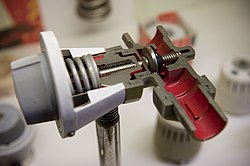 |
Europe |
|
A domestic globe valve installed on heating radiators. The valve opens and close depending on the delta between fluid and ambient temperatures according to spring inside |
Water valves
Water valves used in water networks
| Photo | Location | Tagging | Comments |
|---|---|---|---|
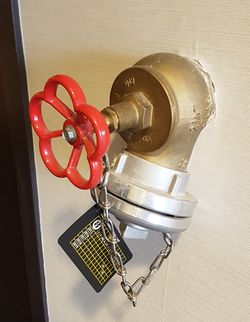 |
The Netherlands |
|
The valve prevent water to get out of a fire fighters riser pipe in a building. This is a typical globe valve |
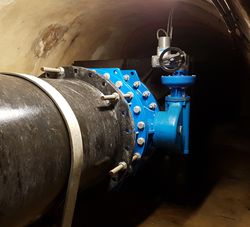 |
France, Toulouse |
|
This is a common valve used to regulate pressure in water mains on distribution networks. Switchable wheel allow technicians to open and close the valve so does the electric actuator on top of it. |
 |
Switzerland |
|
Hydroelectric power plants usually got valves at top and bottom also of their penstocks carrying water down to turbines. Such a valve is mainly fully opened or fully closed depending of the plant operational status. It is located next to a pelton turbine at the end of the penstock. Here is how a ball valve closes : |
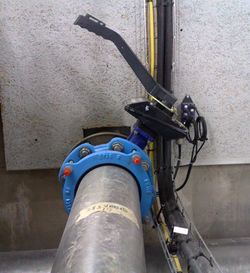 |
France |
|
Such a valve use a movable disk to let or prevent water from passing through it. A lever handle and a sensor allow technician to change the valve state |
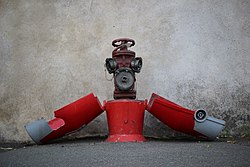 |
France |
|
A fire hydrant with a globe valve to open or close the 3 outlets |
Oil & gas valves
| Photo | Location | Tagging | Comments |
|---|---|---|---|
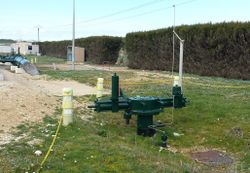 |
France |
|
The valve is actually underground and ensure safety of the rising pipeline on the background. Only its head is visible from the ground surface. |
Pneumatic and industrial devices
| Photo | Location | Tagging | Comments |
|---|---|---|---|
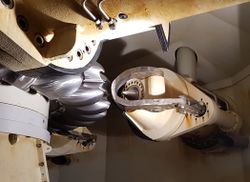 |
Switzerland |
|
A closed needle valve designed to regulate the intake of water toward a pelton power turbine. The opening of the needle allows the water to be directed to the turbine with the appropriate power. |
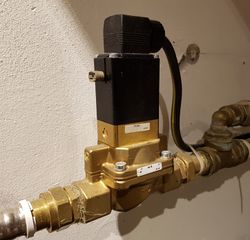 |
France |
|
A comon globe valve which state is modified by a solenoid. A manual button allow local operator to unlock the valve in case of solenoid failure. It is provided by Bürkert. Datasheet |
Voting
Final vote: 13 pros out of 17 votes makes the proposal approved at 76% Curent approval: 16 pros out of 20 votes makes the approval rate at 80%
- Log in to the wiki if you are not already logged in.
- Scroll back down and click "Edit source" next to the title "Voting". Copy and paste the appropriate code from this table on its own line at the bottom of the text area:
| To get this output | you type | Description |
|---|---|---|
{{vote|yes}} --~~~~
|
Feel free to also explain why you support the proposal! | |
{{vote|no}} reason --~~~~
|
Replace reason with your reason(s) for voting no. | |
{{vote|abstain}} comments --~~~~
|
If you don't want to vote yes or no but do have something to say. Replace comments with your comments. |
~~~~ automatically inserts your name and the current date.For more types of votes you can cast, see Template:Vote. See also how vote outcome is processed.
 I approve this proposal. --EneaSuper (talk) 09:44, 23 December 2018 (UTC)
I approve this proposal. --EneaSuper (talk) 09:44, 23 December 2018 (UTC) I approve this proposal. --Brian de Ford (talk) 16:47, 16 December 2018 (UTC)
I approve this proposal. --Brian de Ford (talk) 16:47, 16 December 2018 (UTC) I approve this proposal. -- Gendy54 (talk) 16:53, 16 December 2018 (UTC)
I approve this proposal. -- Gendy54 (talk) 16:53, 16 December 2018 (UTC) I approve this proposal. --Michalfabik (talk) 17:02, 16 December 2018 (UTC)
I approve this proposal. --Michalfabik (talk) 17:02, 16 December 2018 (UTC) I approve this proposal. --Nospam2005 (talk) 17:09, 16 December 2018 (UTC)
I approve this proposal. --Nospam2005 (talk) 17:09, 16 December 2018 (UTC) I approve this proposal. --Fanfouer (talk) 18:49, 16 December 2018 (UTC)
I approve this proposal. --Fanfouer (talk) 18:49, 16 December 2018 (UTC) I approve this proposal. --Renecha (talk) 20:41, 16 December 2018 (UTC)
I approve this proposal. --Renecha (talk) 20:41, 16 December 2018 (UTC) I oppose this proposal. if the keys are moved to a namespace (valve:handle, valve: actuator, valve:handle,...), I would wholeheartedly agree! So we have major keys for more or less very little items! --Waldhans (talk) 21:31, 16 December 2018 (UTC)
I oppose this proposal. if the keys are moved to a namespace (valve:handle, valve: actuator, valve:handle,...), I would wholeheartedly agree! So we have major keys for more or less very little items! --Waldhans (talk) 21:31, 16 December 2018 (UTC)
- Discussion goes on the Talk page.
 I oppose this proposal. I vote no for the same reasons of Waldhans. Tags of this kind should be adequately namespaced. It is true that the same "keyword names", like "actuator", can be used in other contexts too, and this is exactly the reason why I think they should be namespaced, to create a valid taxonomy. (BTW, I think the thermostatic valve pictured in "Domestic devices" is a diaphragm valve, not a globe valve.) --smz (talk) 23:23, 16 December 2018 (UTC)
I oppose this proposal. I vote no for the same reasons of Waldhans. Tags of this kind should be adequately namespaced. It is true that the same "keyword names", like "actuator", can be used in other contexts too, and this is exactly the reason why I think they should be namespaced, to create a valid taxonomy. (BTW, I think the thermostatic valve pictured in "Domestic devices" is a diaphragm valve, not a globe valve.) --smz (talk) 23:23, 16 December 2018 (UTC)
- Discussion goes on the Talk page.
 I approve this proposal. After having read the discussion on the talk page, I am not convinced by the arguments from the opposers --Severin (talk) 11:02, 17 December 2018 (UTC)
I approve this proposal. After having read the discussion on the talk page, I am not convinced by the arguments from the opposers --Severin (talk) 11:02, 17 December 2018 (UTC) I approve this proposal. --Dr Centerline (talk) 16:26, 22 December 2018 (UTC)
I approve this proposal. --Dr Centerline (talk) 16:26, 22 December 2018 (UTC) I approve this proposal. handles, actuators etc may have uses for things other than valves. So namespace may not be appropriate. Warin61 (talk) 23:22, 27 December 2018 (UTC)
I approve this proposal. handles, actuators etc may have uses for things other than valves. So namespace may not be appropriate. Warin61 (talk) 23:22, 27 December 2018 (UTC)
 I approve this proposal. --Fizzie41 (talk) 20:08, 6 January 2019 (UTC)
I approve this proposal. --Fizzie41 (talk) 20:08, 6 January 2019 (UTC) I approve this proposal. --HillWithSmallFields (talk) 20:27, 6 January 2019 (UTC)
I approve this proposal. --HillWithSmallFields (talk) 20:27, 6 January 2019 (UTC) I have comments but abstain from voting on this proposal. I'm in a somewhat difficult position. The newly introduced keys and values look ok. My problem is the usage of
I have comments but abstain from voting on this proposal. I'm in a somewhat difficult position. The newly introduced keys and values look ok. My problem is the usage of pipeline=valveon some of the smaller examples, especially the domestic devices. Unfortunately I checked your proposal right at the start of the RFC-phase when there were none of those and I also didn't notice the short mention of domestic devices in your mail on the tagging list. My issue is with the term pipeline: pipelines are generally considered to be longer distance, see f.e. on Wikipedia. But some of your examples are, in my opinion, outside of this scope. So with regards to the fire hdrant I'd simply removepipeline=valve, I don't think that it's needed here anyway. With domestic devices like radiators, you would probably have to invent a new tag like indoor=radiator or similar and put the information about the valve on that object, again withoutpipeline=valve.
- Another small point, that I just noticed today: I think it's a little unfortunate, that you didn't mention the fact, that
valve=*is already used with a somewhat different meaning. It probably would have been nice to find a way to incorporate the attribute covered by current usage into this proposal. --TOGA (talk) 04:58, 13 January 2019 (UTC)
 I approve this proposal. Benoît Prieur (talk) 06:38, 14 January 2019 (UTC)
I approve this proposal. Benoît Prieur (talk) 06:38, 14 January 2019 (UTC) I have comments but abstain from voting on this proposal. Comprehensive concept! Excellent presentation! In some details it exceeds the demands of OSM. --Schröcker (talk) 21:51, 15 January 2019 (UTC)
I have comments but abstain from voting on this proposal. Comprehensive concept! Excellent presentation! In some details it exceeds the demands of OSM. --Schröcker (talk) 21:51, 15 January 2019 (UTC) I approve this proposal. --AlexModesto73 (talk) 21:33, 16 January 2019 (UTC)
I approve this proposal. --AlexModesto73 (talk) 21:33, 16 January 2019 (UTC) I approve this proposal. --atabaraud (talk) 23:09, 16 January 2019 (UTC)
I approve this proposal. --atabaraud (talk) 23:09, 16 January 2019 (UTC)
 I approve this proposal. --Rdesgrange (talk) 13:25, 17 January 2019 (UTC)
I approve this proposal. --Rdesgrange (talk) 13:25, 17 January 2019 (UTC)
